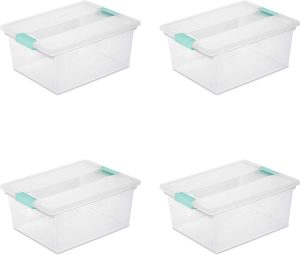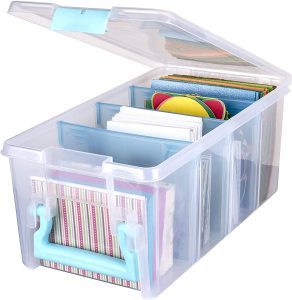The Best Book Storage Box

Our Review Process
Don't Waste Your Money is focused on helping you make the best purchasing decision. Our team of experts spends hundreds of hours analyzing, testing, and researching products so you don't have to. Learn more.
Our Picks For The Top Book Storage Boxes
- 1. Leffis Water Resistant Easy Install Book Storage Box
- 2. Fab totes Reinforced Handle Collapsible Book Storage Boxes, 3-Pack
- 3. Sterilite Large-Clip Clear Book Storage Boxes, 4-Pack
- 4. Bankers Box Classic Lidded Cardboard Book Storage Boxes, 20-Pack
- 5. INough Drawstring Linen Waterproof Book Storage Box
- 6. CHEAP! CHEAP! MOVING BOXES Cardboard Book Storage Boxes, 20-Pack
- 7. ArtBin Plastic Book Storage Box With Dividers & Handles
- 8. Amazon Basics Reusable Collapsible Book Storage Boxes, 20-Pack
Available in black or gray, this waterproof book storage box is designed to neatly hold your comic book collection. In fact, it's sturdy enough to hold as many as 150 comics. When not in use, this bin collapses for easy storage.
Affordable PickYou'll find this book storage box won't break your budget.
You'll get not one, not two, but three book storage boxes when you opt for this set. Each is constructed using a stylish fabric and outfitted with strong handles made from rope. Use the bins to neatly organize everything from baby albums to nursery rhymes story books to wooden puzzles.
Choice of ColorsYou'll find this book storage box comes in a choice of gray, blue or black.
In this set, you’ll get four boxes and four lids, each sized 14 x 11 inches with a 6.25-inch depth. They’re clear, allowing you to easily see internal contents even when they're stacked. The lids clasp tightly, too, so your items stay safe, moisture-free and secure whether you're moving or storing them.
For Smaller ItemsPaperbacks, notebooks and smaller books fit perfectly in these clear, lidded plastic book storage boxes.
With easy-carry handles and a folding design that doesn't require any tape, these corrugated, recycled cardboard storage boxes are great for moving or storage. The lift-off lid lets you easily access internal contents, and there's plenty of space for labeling. Pick the number and size you need, up to 30.
Great for LibrariesIf you have a large collection of books you need to store, you'll want this set of book storage boxes.
Buying Guide
Books are precious commodities. Whether it’s your home library or your children’s favorite picture books, you want a way to keep them safe when they aren’t in use. At the very least, you may eventually need to pack your books up and move them, which requires the appropriate storage box.
If you’ll be storing your books for any length of time, though, the best box likely isn’t a box at all. Storage containers will help keep moisture at bay and reduce the risk that your books will suffer light exposure, which can make chemical changes on paper, leather and cloth.
You might be surprised to hear, though, that there’s a good reason books are typically stored in bookcases. Airflow is good for books. It keeps the pages dry, reducing the risk that pages will become brittle due to humidity exposure. Ideally, you’ll store your books in an interior room so that sunlight and heat won’t affect their pages.
Both plastic and cardboard will work for storing your books short term. Plastic bins that seal up completely can prevent outside humidity and moisture from seeping in. But, if you go that route, you’ll need to make extra sure there’s no lingering moisture when you place your books inside, since that airtight seal will also ensure any moisture inside can’t get out. Silica gel packets can help give you a little extra protection. For long-term storage, consider acid-free archival boxes and make sure you keep your books in a dry, dark, temperature-controlled location.
What to Look For
- Many storage containers come with lids. If you choose this option, make sure the lids seal up tight, both to keep moisture out and to ensure the lid doesn’t come off while you’re carrying the box. Easy-carry handles can come in handy for moving your boxes from one place to another.
- Multiple containers or boxes will probably need to be stacked for the most efficient storage. Look for containers or boxes with lids that easily fit together, so you can put boxes on top of each other.
- If you’ve decided to get a cardboard box for your books, look for corrugated cardboard. This is stronger than regular cardboard, so it’ll hold more books. You can also find cardboard boxes made from recycled material if you’re concerned about eco-friendliness.
- While they’re in storage, you’ll occasionally need to track down one or more of the books you’ve packed away. Some containers are clear so you can see internal contents, and others are made for easy labeling of their contents. Be as specific as possible when you’re labeling; you may be grateful later when you’re searching for a book.
- One thing to consider is how heavy books can get when packed into a box, especially hardcovers. You’ll want to limit the number of books you stuff into each box.
- Before you buy a storage container, you may wish to measure your valuable books and make sure they’ll fit inside. Some containers may work better if you lay books flat, while others may allow you to insert them vertically.
- It’s important to do everything you can to prevent mold and mildew during storage. You’ll want your books to be completely dry before you box them up. Don’t wrap the books in plastic since that can trap moisture and cause problems. You’ll also want to avoid wrapping them up in newspaper since the print can rub off on the books. Instead, consider using archival paper.
More to Explore
If you’re a true bookworm, you probably think living in a library would be a dream. At one time, it wasn’t all that unusual. As of 2017, New York City featured 13 abandoned areas inside libraries that were once living spaces for people.
In the early 1900s, ultra-wealthy steel magnate Andrew Carnegie gave $5.2 million to New York City to build new public libraries around the city. At the time, spaces had to be heated with coal, which created a quandary for the city. Someone needed to be on-site around the clock to keep those furnaces going. The solution was to build apartments above the libraries where maintenance people could live. Those library custodians often had families, of course, which meant some children grew up living above one of the more than 30 Carnegie libraries scattered around the city.


















